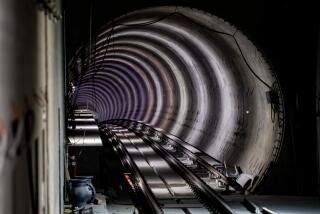The MTA’s road to ruination
ON THE MORNING of May 24, the Los Angeles MTA board will hold a public hearing to consider a series of draconian fare increases — raising the $3 daily pass to $5 and then $8, the $52 monthly pass to $75 and then $120 — rates put forth as a trial balloon by its employee, Chief Executive Roger Snoble.
It’s all a calculated ruse. The board of the Metropolitan Transportation Authority hopes that when, under massive pressure, it tries to make only unbearable increases rather than excruciating ones, a naive and servile public will thank the board for its mercy. In fact, any fare increases would be a disaster for Los Angeles, reducing transit ridership, increasing pollution and hurting the city’s poorest residents.
Bus riders, in particular, cannot afford a fare increase. The core of the MTA’s 500,000 public transit riders are the black and Latino working class who use public transportation every day. The majority can hardly afford the current $3 daily pass ($90 a month) or the $52 monthly pass.
Say the MTA tries to raise the monthly pass price $10. That would mean $50 a month for a family of five, $600 more a year, and an annual family transit bill of $3,720.
We have been down this road before. In 1994, the MTA almost destroyed its bus system in order to subsidize contractor-friendly rail projects that were racially discriminatory. Light rail costs $150 million a mile and subways $280 million — and to pay for construction overruns and operations, the MTA raided the bus funds. At the same time, the MTA announced its plan to raise fares to $1.35 from $1.10 and eliminate monthly passes.
The Labor/Community Strategy Center and the Bus Riders Union, represented by the NAACP Legal Defense and Educational Fund, rushed into federal court to charge that the MTA was violating Title VI of the 1964 Civil Rights Act, which forbids the government from allocating money in a racially discriminatory manner. The court issued a temporary restraining order and forced the MTA to re-institute the monthly pass. Among those who testified in support of the Bus Riders Union was Antonio Villaraigosa, then deputy to MTA board member Gloria Molina.
Out of that litigation, the center and the Bus Riders Union signed a 10-year consent decree with the MTA, which agreed to dramatically improve the bus system. The consent decree secured a $42 monthly pass and an $11 weekly pass (though pass fares went up $10 at the start of 2004). The MTA replaced 2,000 dilapidated diesel buses with 2,500 natural gas buses and now boasts that it has “the largest clean-fuel bus fleet in the U.S.”
The not-so-secret story is that the MTA refused to buy those buses, appealed every court ruling and buckled only after the Supreme Court refused to hear its hollow appeals.
The federal District Court lifted its oversight of the MTA in October, and only seven months later the MTA is regressing to its race- and class-biased policies — cutting bus service and threatening to raise fares. The MTA is back to creating a separate and unequal public transit system, giving massive subsidies to the significantly whiter rail ridership while complaining that it cannot afford what are truly tiny subsidies to bus riders, who are 60% female, 85% black, Latino or Asian and many of whom have family incomes under $15,000.
Buses are the only viable alternative to cars for a county of 10 million people spread over 4,000 square miles. Just four miles of subway drilling cost $1.2 billion; for the same price the MTA could buy 2,600 clean-air buses and double the size of the existing fleet.
By contrast, service cuts and fare increases will depress ridership, leading to more cars on the road and dramatically increased pollution. (In L.A. County, 70% of greenhouse gas emissions are from cars and trucks.) Any attempt to raise fares should require an environmental impact report. High-speed bus-only lanes — combined with prohibiting cars altogether in auto-free zones and during auto-free days — are the only ways to reverse the rise in respiratory illness and global warming.
The MTA, claiming a $100-million operating deficit, wants us to believe that punishing its riders is its only choice. But it continues to subsidize rail projects at absurd levels.
About $57 million is spent on operations for Metrolink — a subsidy of about $5 a rider — which serves the whitest, most affluent suburban transit users. For the Gold Line, weekday ridership is 19,000 at an operating subsidy for each passenger of almost $7. The three Wilshire/Whittier bus lines, the most heavily utilized and effective in the nation, carry 90,000 daily passengers at a subsidy of 79 cents each.
The 13-member MTA board needs a two-thirds majority to raise fares, so five “no” votes would kill any fare hike. If Villaraigosa and his three appointees (Bernard Parks, Richard Katz and David Fleming) vote against it, then just one more “no” vote — maybe from Molina or one of the other county supervisors — would stop this attack on passengers and put the MTA’s rail addiction back in permanent rehab.
More to Read
Sign up for Essential California
The most important California stories and recommendations in your inbox every morning.
You may occasionally receive promotional content from the Los Angeles Times.










